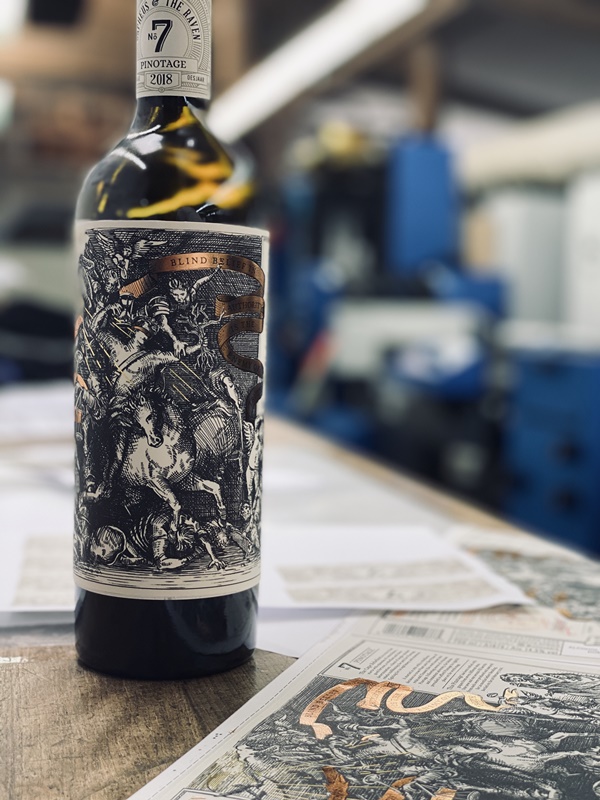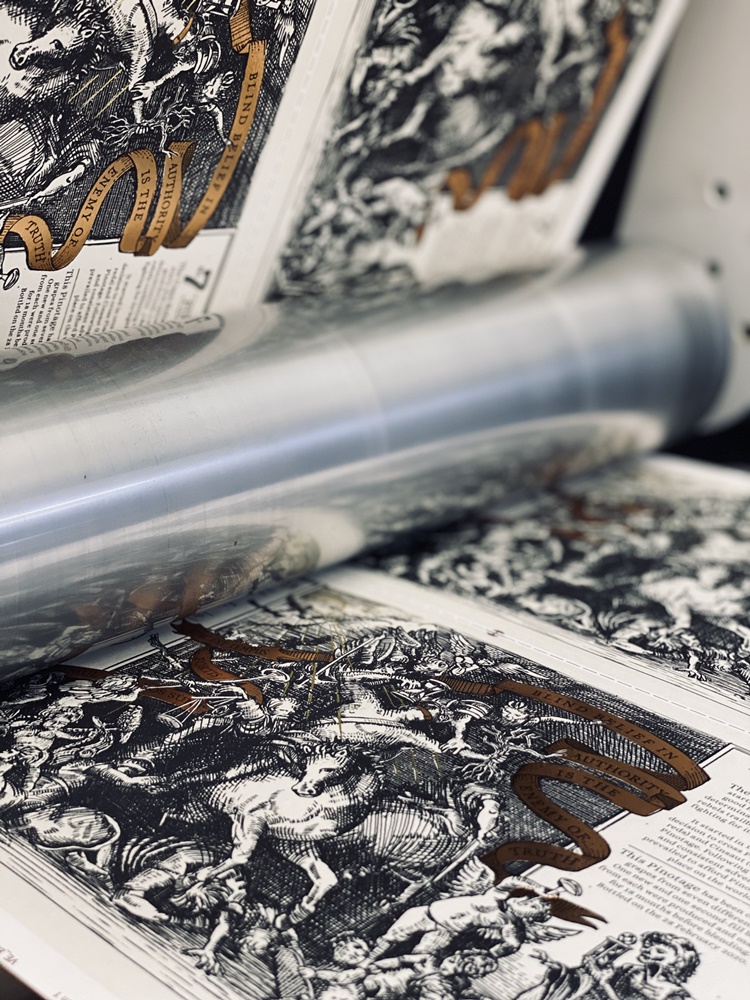P3 5-6/2022 en
Wine Marketing
“The Waste of Energy in German Viticulture is Complete Madness.”
Trends & Practice

Orpheus & The Raven: Winner of The Drinks Business Award 2020 in the category “Best Design & Packaging”.
“Red wine is for good old boys / always one of the best toys,” my grandfather of blessed memory used to say. So far so good. But: Why do I buy a certain bottle? How sustainable - or energy-intensive - is the production of an attractive, possibly award-winning packaging and bottle really? And: How sustainable is the cultivation? Is the winery transparent about its carbon footprint? What condition is the ground in? Is the overall concept competitive and sustainable at all? And how much illusion do I buy?
Anyone who works in the Wine Marketing & Management course at Heilbronn University has to cope with more than just delicious wines and packaging finished with metal foil. They need answers to the questions asked and extensive knowledge of both marketing and viticulture. P3 spoke to Friederike Watzl and Prof. Dr. Daniel Deimling, both established scientists in that very course.
Orpheus & The Raven: Winner of The Drinks Business Award 2020 in the category “Best Design & Packaging”.
Ms. Watzl, maybe you would like to start by telling us something about the work and the challenges in the "Wine Marketing & Management" department?
F.W.: Gladly! The Wine Marketing & Management course at Heilbronn University is a full-time Bachelor’s degree (Bachelor of Arts) that can be completed within 7 semesters at the Heilbronn Education Campus (https://www.hs-heilbronn.de/de/wmm). The Wine Marketing and Management course has existed in Heilbronn for 35 years (in the past it used to be called Wine Business Administration and then International Wine Marketing). The Wine Marketing and Management course forms the ideal basis for all graduates to later be able to help shape the exciting wine industry. For a wine industry that wants to remain competitive in the future, executives and well-trained managers who are able to face the complex problems of the wine market are essential. Increasing competition, globally networked markets and increased price competition require not only in-depth business knowledge but also a broad knowledge of wine.
However, in addition to the great and fun work with the students, the education industry in general is now also a highly competitive market. It's all about the number of applicants. It feels like the range of educational opportunities around us is growing every day - so the number of applicants is spread over a significantly larger number of institutions. It's more important than ever to do marketing, even for the degree that studies marketing.
Now more than ever, alcoholic beverage packaging in general, and wine packaging in particular, seems to be a playground for all sorts of design variations and finishing techniques imaginable. Can content-related deficiencies be concealed with an elaborate and eye-catching packaging design? Or to put it another way: Do today's buyers judge the packaging more, or does the contents of the bottle leave a more lasting impression?
“A bottle or alternative packaging that isn't pretty doesn't really make you want more either.”
Friederike Watzl
F.W.: According to my observations, it always depends on which channel the wines are bought through and which target group is to be addressed. But I would still say that the eye always participates (at least in the case of the younger generations). A bottle or alternative packaging that isn't pretty doesn't really make you want more either. On the other hand, a bottle that does look pretty (although that is, naturally, always in the eye of the beholder and therefore specific to the target group) is something people like to put on the table, and if it is #instagramable, photos of it even end up on social media. This in turn ensures reach and, in the best case, increases awareness in the long term.
In my opinion, you should definitely make sure that the packaging and the design are appealing. However, product defects cannot be concealed in the long term. At the latest after the first purchase and then the disappointing sip, consumers would not buy a second time. Of course, this should also be due to the manufacturer's own requirements! It's the same as with other branded products: the quality in the bottle should always be right - and the look and packaging can then convey the value to the outside world.
Well-known sommelier, presenter and entertainer Antonios Askitis recently said: “I'm more attracted by the contents of a wine bottle than by its presentation. It's what's inside that counts; not what is outside. Innovations are door openers, yes. But not because they are technically or graphically well made.” Which methods can be used to statistically measure the effort that goes into effects and designs?
F.W.: This can be done with market research, i.e. with surveys and eye tracking.
Do you have the impression that elaborately designed packaging is often only used as "the emperor's new clothes" in order to be able to sell the same wine at a higher price than before?
F.W.: Such examples can be observed again and again in the wine industry. It's the power of marketing. A new edition of the design, the packaging and the story behind it has a lot of marketing potential - a limited edition of the same product with a special label related to the occasion, for example. It is quite possible that a special edition or co-creation can be “re-launched” on the market, without the content being “re-invented”. There's nothing wrong with that, it's still not the same product after all, and a price adjustment can therefore be justified. There are always exceptions. This is not only the case in the wine industry, but can also be observed in many other industries - not least in the areas of beauty and fashion.
The mixture of materials used - for example combinations of cardboard and hot foil finishes - can in some cases lead to difficulties with recycling. Does the will to sustainability too often end where the battle for customer attention begins?
“It is often too easy to stick with the tried and tested.”
Friederike Watzl
F.W.: From my point of view, there is no general answer to this question. My guess is: Unfortunately yes! It is often too easy to stick with the tried and tested - or it has not yet been sensitized and clarified. Active education on the part of label and packaging manufacturers is required to show where the idea of ??sustainability can begin.
In your opinion, are there materials and techniques that are still underused in the packaging sector?
F.W.: Yes – from the bag in the box and recycled lightweight glass bottles in the returnable deposit system to returnable stainless steel barrels, self-fill/refill shops (with containers you bring with you) and unpackaged shops. Ultimately, this applies to all materials and techniques that save resources (keyword carbon footprint) while still being suitable for getting wine clean and protected to consumers.
How badly have German winegrowers been affected by the effects of climate change (storms, periods of drought, excessive heat, late frosts...) – also from a regional perspective – and how are they reacting to this?
D.D.: Water bottlenecks are becoming more and more common in Germany. It is well known that vines have deep roots and are relatively resistant to drought stress, but even that has its limits. If long-term periods of drought become normal and the groundwater sinks further and further, this becomes an existential threat for vineyards.
In the “summer of the century” 2003, a problem became apparent for the first time that will play a dominant role in the vineyard in the future: Synthetic fertilizers, which are applied in the form of nutrient salts, among other things, are only absorbed by the vines if there is enough water. If the soil is dry and there is no precipitation, the applied mineral fertilizer simply remains in the soil and the vine is not supplied with nutrients. Therefore, in 2003, there were a striking number of vineyards in conventional viticulture that suffered from deficiency symptoms, in particular from a lack of nitrogen. In the drought years 2018 to 2020, this was repeated in some regions that were affected by prolonged drought. In the next few years, the undersupply of synthetically fertilized vineyards due to long periods of drought will increasingly become a problem. The organically fertilized vineyards usually do not show these deficiency symptoms, since the nutrient supply is not dependent on precipitation.
In conventional viticulture, every second row of vines is still often kept open so that the mineral fertilizers are available to the plants more quickly. With increasing heavy rain events, the topic of soil erosion becomes virulent in open rows of vines. Vineyard soils on slopes that are kept open are washed away by heavy rain. In flat areas, so-called wind erosion occurs more frequently during storms. According to the federal government's soil condition report, this is another reason why fertile topsoil is lost every year. Organic fertilization and the creation of a nutrient-rich humus layer through sowing (legumes, flowering plants, etc.), greening and the introduction of compost will form the basis for healthy vineyards in the future. Humus and sowing ensure good root penetration and aeration of the soil, increase the water and nutrient storage capacity of the soil, promote soil life and biodiversity, reduce soil compaction and offer protection against erosion.
On humus-rich surfaces, crumbs of heavy soil stick together less, which means that the soil is less compacted, rain seeps away more quickly and erosion is avoided. Humus is a source of nutrients for the vines - through microbial degradation of the humus components, organically bound elements are converted into plant-available compounds. Humus is also a food source for microorganisms and soil animals. The proteins in humus prevent major pH fluctuations, an important prerequisite for biochemical processes in the soil. The humus influences the pore system as well as the air and water balance of the soil. In addition to the water storage capacity, water seepage and water stability of the soil, root development is also improved: the vines root deeper. Humus, sowing and greening play a key role in climate adaptation because they increase the resilience of the vineyards in many ways in the context of droughts and heavy rain events. However, the build-up of a healthy humus layer requires a lot of time, in the literature it is assumed to be around 20 years. If winegrowers only begin to build up humus when mineral fertilization is no longer possible or affordable, it is in most cases too late.
Viticulture is severely affected by climate change and the changes are already visible today. The occurrence of new diseases such as Esca and new pests such as the spotted drosophila (Drosophila suzukii) in Germany is also attributed to climate change. However, the wine industry is not only affected by climate change, but also contributes to global warming itself, since fossil fuels and materials are used at every process stage and in almost every work step, the production and transport of which produce greenhouse gases. German viticulture urgently needs a resounding climate protection strategy.
“The one-way system, which predominates in German viticulture, is completely anachronistic, and the waste of energy is complete madness.”
Prof. Dr. Daniel Deimling
The first step is for wineries to create transparency about their greenhouse gas emissions. The next step is to reduce these as much as possible, and the last step is to compensate for the remaining greenhouse gas emissions. Since humus is one of the most important carbon sinks, this is also a key to more climate protection in viticulture. 57 percent of the greenhouse gas emissions from a bottle of wine are caused by the packaging (glass bottle, closure, label, carton, foil). The packaging is therefore the biggest lever that needs to be addressed. In the course of the gas bottleneck of the last few months and the associated supply bottlenecks for glass bottles, German winegrowers slowly became aware of how much energy is required to produce a glass bottle. The one-way system, which predominates in German viticulture, is completely anachronistic, and the waste of energy is complete madness. There is absolutely no question that we need a comprehensive reusable system with uniform lightweight glass bottles in viticulture.
The amendment to the Fuel Emissions Trading Act has been in force since January 1st, 2021. Companies must initially pay €25 per tonne of CO2, gradually €55 by 2025 and €65 from 2026. So far, only companies from the energy sector, energy-intensive industry, transport and buildings have had to pay for CO2. It is only a matter of time before agriculture and thus viticulture will be added. Wineries that start to minimize their greenhouse gas emissions today will in turn have a clear competitive advantage. Sustainability seals such as FairChoice focus on the CO2 balance and try to create awareness of this problem. Both input (energy, resources) and output (emissions, waste) will become more expensive in the future. Wineries that require little energy-intensive input due to their way of working and that produce little waste and emissions are not only sustainable in an ecological sense, but also economically because they will have lower costs in the future. They are less affected by price increases for energy and raw materials and thus have planning security. The farewell to conventional viticulture and synthetic fertilization does not have to be ecologically motivated, but can be made for tough business reasons.
In your experience, how are German wines and the associated designs perceived abroad?
F.W.: There is no general answer to that. But I think it always depends very much on the wine, the export country and the desired image. For example, for the export lines often different designs are chosen compared to wines intended for the German market. There is a reason for that, as you can imagine. What I suppose: Typical designs and symbols for Germany are used on labels abroad. These include racks, traditional costumes, the Black Forest, the Oktoberfest - such things create immediate associations with Germany and German wines.
With its export line, the German Wine Group has managed to develop distinctive features and incorporate them into the design of its product line. And then of course there's the logo - and that includes the colors of the flag. In my opinion, this is a best-case approach.
In an article on the topic of packaging innovations in the wine industry that we recently published (http://www.p3-news.com/De/News/22552), you suggested using “trend scouts in other countries purposefully“. What impulses would you hope for from this and what is the German (wine) packaging industry perhaps not as good at as others?
F.W.: Well, new ideas come from getting inspiration. This is only possible if you keep your eyes open and think outside the box. In other countries, for example, there are different circumstances (climatic, infrastructural, etc.) and customer demands to which the local companies react and thereby create new approaches, products and packaging. Who says that an idea can't also work in Germany? Trend scouts can be used to discover what works in other countries. That allows conclusions. You keep thinking!
Do you prefer red or white wine?
F.W.: Definitely white wine. Preferably even embellished with pearls – I'm a champagne fan (laughs).
Last question: Which wine that perhaps still gets too little attention, or which wine region would you recommend to our readers?
F.W.: Armenia! We were there recently on a field trip with the course. It is one of the oldest wine countries in the world and yet so unknown in Germany. If you have the opportunity to taste wines from there or even travel to Armenia: Definitely grab the opportunity and taste it!
Ms. Watzl, Professor Deimling, thank you very much for the interview!

MA Friederike Watzl, project and course coordinator in the course of Wine Marketing & Management, Heilbronn University.

Prof. Dr. Daniel Deimling, head of the Wine Marketing and Management course at Heilbronn University.
Editor: sbr
Images: Vollherbst [1,4]; Hochschule Heilbronn [2,3]







